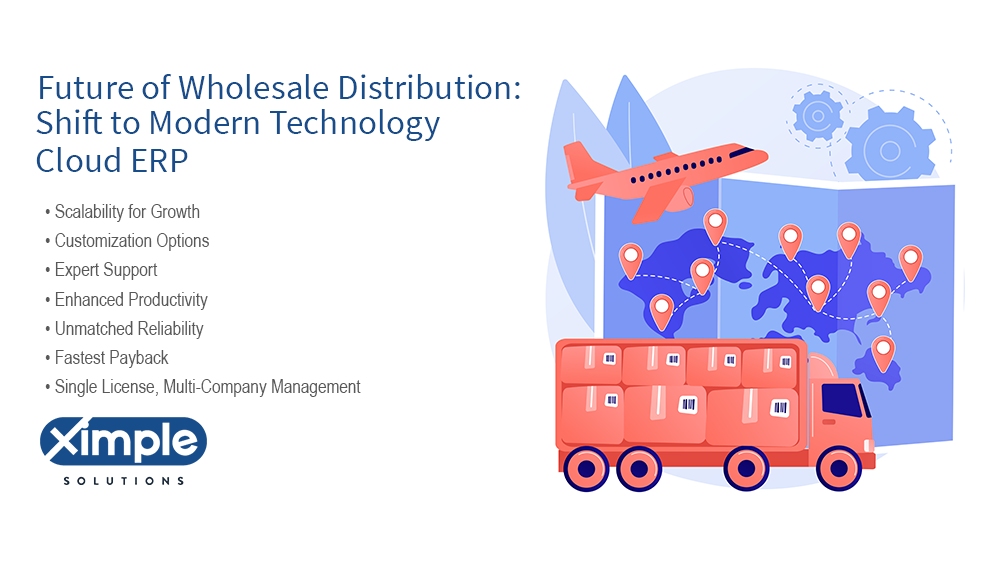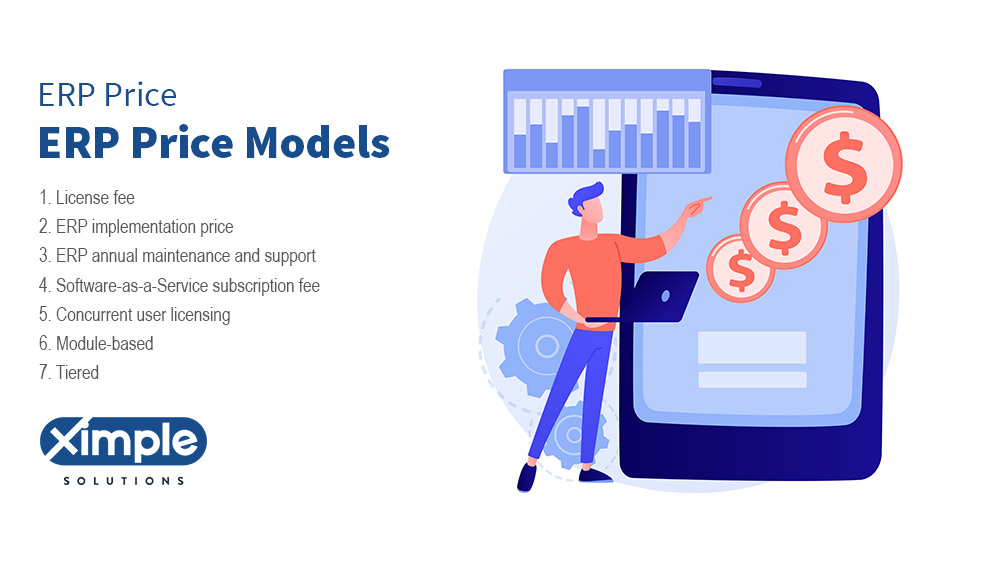What is a Distribution Strategy? Importance of Distribution Strategy
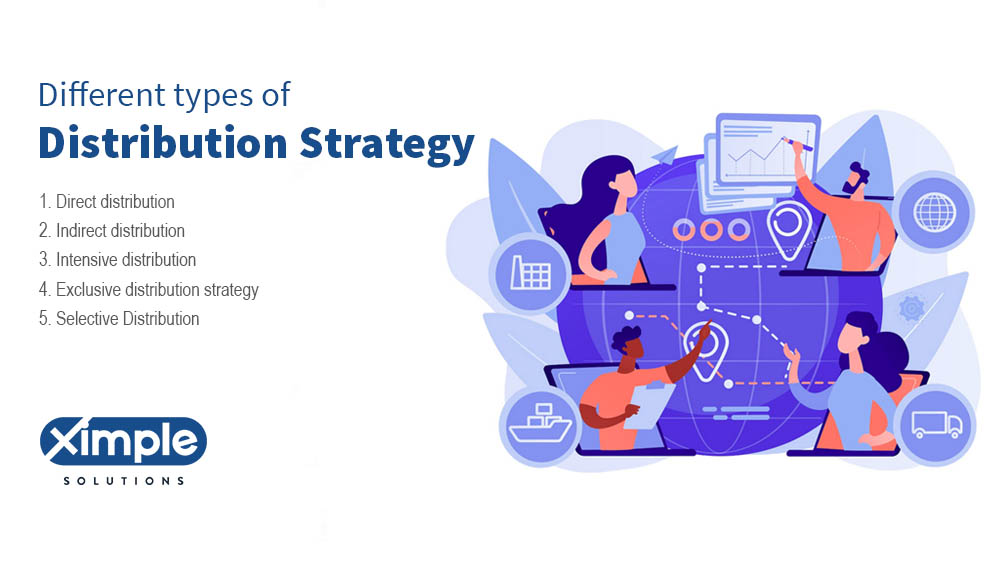
Did you know that sales are the key to higher revenues and contented workers? That’s true, and if you want to sell more, you should make a plan. First, you should have a goal to attract and retain customers. Second, you should deliver a product or service to the customer and the correct information. To achieve this, you should come up with a distribution strategy that goes well with your business needs. This strategy will help you manage the complete sales process. But, do you know what it is all about? If not, don’t worry; this guide will educate you.
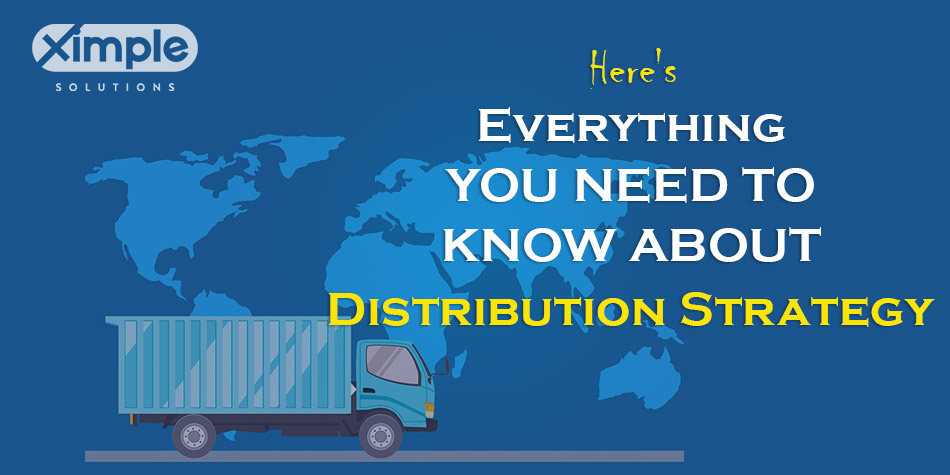
Table of Contents
- What is a Distribution Strategy?
- How to select the right Distribution Strategy
- Distribution Strategy: Stay competitive in the Digital world
- Distribution Strategy examples
- What are different types of Distribution Strategy?
- What are different distribution Channels?
- How can I select the right distribution strategy for my wholesale business?
- Key Modules of the Distribution Software
- What is the difference between Direct and Indirect Distribution
- Conclusion
What is a Distribution Strategy?
In a nutshell, the best distribution strategy definition is a plan to help you deliver a product or a service to the customers you are targeting via a supply chain. This plan includes all the approaches you would use to give the customers what they expect from you. A good strategy can incorporate your distribution channels or employ other companies’ channels. In addition, your business can use its exclusive stores or sell through other retail stores.
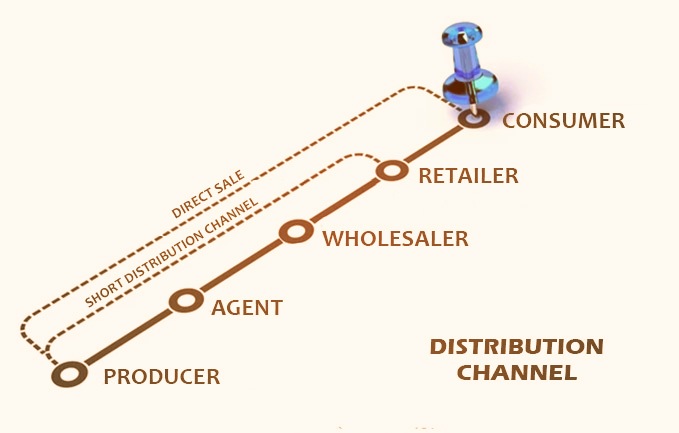
Moreover, a business can use both its stores and third-party retail chains. In modern times, especially after the Covid-19 epidemic, companies are using online exclusive sales channels. Hence, you should pick a distribution channel strategy that suits your business. The best approach will help you deliver goods or services to the target audience at optimal distribution costs. It will also maximize your sales revenues and profits. On the other hand, Bad distribution strategy types will cause losses and let your competitors win.
How to select the right Distribution Strategy
Now you know what a distribution strategy is. Next, you will learn how to select the right one for your business. There are a few factors to reflect on, and they include:
Check the market status right now
Before coming up with a distribution marketing strategy, carry out a thorough market analysis. The goal is to discover the correct way to distribute the type of products you sell. For instance, if you deal with consumer goods, the proper technique is FMCG distribution. Only a meticulous market analysis can reveal the appropriate distribution channels for your products. It can also help you study customers’ buying behavior and pinpoint their specific needs.
Distribution costs
No matter the channel you choose, there will be costs to incur. If you select a more comprehensive direct distribution strategy, it means you will sell directly to the final customer. The method is more straightforward, but it has some costs to incur. The more comprehensive strategy involving intermediaries is more convenient, and goods can reach customers almost immediately. However, every intermediary should earn something to continue being loyal to you. In essence, you should develop charts and graphs showing potential costs and profits from each distribution channel.
Do you sell complex or simple products?
As you try to create a sales distribution strategy, focus on your product. The product is complex in that it requires technical support after delivery. Do the customers need an after-sale service, such as installation and maintenance help? If so, you should sell it more directly to go to a dealer and then to a customer. The dealer will help your customers sort out their issues. On the other hand, if your product is a typical household appliance, such as a blender, you can select an extended distribution channel for it.
What profits are you targeting?
If you choose the shortest distribution method, your business revenues can increase. Nonetheless, this can happen only if you don’t sell FMCG products. For these, you need a more extended distribution channel to increase your revenues and profits. In some situations, higher revenues may not translate to higher net profits.
What will be your market share?
How quickly can your business establish itself in a new market? If such a market is already saturated, you will find it hard to penetrate a new market. There will be competitors doing well already, and it will take longer to get a market share. So you have to do you distribute strategy math very carefully.
Where your product is in its life cycle
If your product is new, a more extended distribution channel is necessary to ensure it is recognized on the market. As you choose who to connect and grow with, you should consider their availability and expertise.
Distribution Strategy: Stay competitive in the Digital World
As you think of how to make a distribution strategy, focus on technology. First, think of how to use technology to promote and sell your products. In this case, you should explore eCommerce as a distribution channel. It is estimated that by 2021, e-commerce sales will reach 4.8 trillion. Why wouldn’t you want to be part of that? Countless people are using apps to buy things online, and you can sell to them too. Secondly, you can use technology to implement your preferred distribution strategy. As you will learn below, there is software that can help you manage your supply chain processes
Distribution Strategy examples.
A suitable distribution strategy example will vary depending on the marketing channels you have selected. First, a direct channel occurs when a manufacturer sells straight to the consumer. The channel must be short if it’s direct. Hence, good examples of this are primarily retail brands that sell fast foods and perishable goods.
An indirect marketing channel, it occurs when the path is long and complex. Typically, there will be many distributors and middlemen. Examples can be soft drinks companies, including Coca-Cola and Pepsi
An intensive distribution strategy is more intensive and considers more than just the size of a distribution channel. It uses a more aggressive approach, and examples include vehicle brands and distributors of household appliances.
Moreover, a business can use an exclusive strategy when it has a high brand value to protect. It will open stores in major cities with upper-income and classy customers and still outdo its competitors. Examples are big fashion houses with high-end designer products.
Lastly, some businesses use a selective distribution strategy. You will find them on almost every street, or they may start a few stores in every major town. Good examples are big supermarkets and retail chains.

What are the different types of Distribution strategy?
Direct distribution

Here, manufacturers sell directly to the end consumer. Some direct distributors sell online, particularly those targeting younger generations that have more technological knowledge. The rest use product catalogs, product lists, phone calls, and other advertising methods.
Indirect distribution
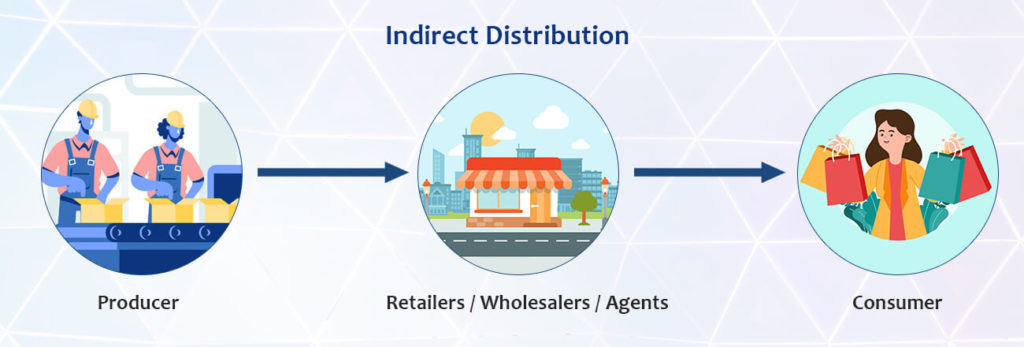
It is the opposite of the direct distribution method. Simply, this method entails intermediaries like wholesalers, retailers, and agents.
Intensive distribution
As aforementioned, this technique entails a more aggressive and extensive marketing approach. Hence, several retail outlets are opened to reach more customers and increase sales revenues and profits.
Exclusive distribution strategy
This method is a preference of companies that sell luxury goods. To purchase their products, you must approach their dealership. A good example here can be the Mercedes Benz car brand.
Selective Distribution
This technique is partly similar to intensive and exclusive strategies. Those who use this technique know full well that not all people will be interested in their products. So they set up stores in some selected areas. Their stores don’t sell anything else, and if they pick external stores, these will sell closely related products.
Related articles
What are different distribution Channels?
These channels are all about how to distribute products to customers. As a distributor, you obtain goods, store them, and then sell them to customers via a distribution channel. Different channels include the following levels:
- Zero – This distribution channel involves direct contact between manufacturers and customers. It is the shortest.
- One – This one entails one middleman standing between the manufacturer and the consumer.
- Two – It involves two intermediaries, and this can be a wholesaler and a retailer.
- Three – This distribution channel has three middlemen, namely: agent, wholesaler, and retailer.
How can I select the right distribution strategy for my wholesale business?
If you are a wholesaler, you need a product distribution strategy that works for your business. There are different types of systems, but some may not work for your business. The system that might work for you might not help the next wholesaler. You can opt for direct marketing via telemarketing and product catalogs or choose eCommerce marketing. It can be trial and error at first, but eventually, you will discover the best strategy for your business. Briefly, you should:
Know your customers perfectly
Ensure you find out who your target customers are, what they need from you, how soon they want it delivered, and where
Focus on your product
If you sell perishable goods or daily-use products, by all means, choose a direct channel. On the other hand, if you deal with non-perishable goods, choose indirect marketing channels. More to the point, select your intermediaries wisely.
Seek professional help
As a wholesaler in any industry, you have competitors. Any small error in decision-making can cost your business considerable losses in terms of time and money. Thus, if you honestly can’t select the right distribution strategy alone, find a professional who can help you.
After finding a distribution strategy to get the message to customers, the next thing is to implement it. As technology has become more innovative than ever, you should use it in your business. More specifically, you should start searching for the best distribution software. It would be best if you bought wholesaler distribution software as it is designed for your business. Not only will it make the distribution process easier to track, but it can also reduce human errors and stress.
A good software tool for distributors should have automation capabilities. In other words, it should boost productivity and ensure that you complete tasks quickly. Another component of this software is RFID tracking which simplifies inventory monitoring in real-time. It is based on a modern technology called the Internet of Things. Moreover, the software needs to have all business management modules in a central position. The most common modules are accounting, warehousing management, customer relationships management, inventory management, and procurement management. Lastly, the software should be cloud-based rather than in-house. Cloud-based distribution software is easy to access from any place, anytime, as long as there is a Wi-Fi hotspot and mobile gadget.
Key Modules of the Distribution Software
Distribution software includes modules to manage plan, administer, execute, track, and report the tasks running in Distribution warehouses that belong to wholesale distributors business. Distribution software contains the ‘Flow’ of material for distributors. Key Features of the Distribution Software are:
- Sales Order Management
- CRM
- Inventory Management
- E-Commerce
- Product Catalog
- Employee Management
- Billing
What is the difference between Direct and Indirect Distribution?
In direct distribution, the product is distributed to the end-user from the manufacturer’s or distributor’s warehouse. This is usually the case for a manufacturer that sells its items via a distribution center or retail outlet. In indirect distribution, the product (i.e. a service) is provided through a supplier or agent who’s contractually obligated through the manufacturer to buy the products and supply them to the end-user. The indirect distribution technique is regularly used by manufacturers and distributors to make certain they don’t oversell or have leftover products.
Direct Distribution = Direct-to-consumer (DTC) is a distribution channel that is not utilized by the brand. The main reason for the use of this channel is to gain a competitive benefit as it is a quicker and more direct way to reach the customer. Companies use direct distribution channels for customer products as it is very effective. This is a direct method of reaching the consumer with the product.
Indirect distribution is an indirect form of distribution channel and is used to sell products and services. It is also called indirect marketing. It is a form of marketing that involves a company or individual taking someone else to make a sale for them. This is known as indirect distribution as it does not involve the company or individual going to the customer directly.
FAQ about Distribution Strategy?
1. What are the 4 types of distribution strategy?
First, a distribution strategy is a plan for distributing goods or services to customers. Successful distribution of your product or service will depend on your selling strategy. There are four distribution strategies, and they include the following:
- Direct – A manufacturer uses a direct distribution method when they want to avoid intermediaries. They can create an eCommerce website and sell their item to direct online customers. Alternatively, they can use catalogs or sell directly via phone calls. The best-selling method for a company depends on the customers’ technical knowledge and age.
- Indirect – This technique includes an intermediary that delivers goods to the customer. Thus, an indirect marketing channel is longer than a direct one. A company will consider the type of items it produces and the customers it wants to reach. An indirect distribution technique can include wholesalers who take goods directly from the manufacturer. After that, they sell these goods to retailers who distribute them in small quantities.
- Intensive – A manufacturer chooses many retail shops to which they deliver their product. An Intensive distribution method suits items like candy or biscuits. These snacks sell fast regardless of the location or shop type. As customers buy these snacks on impulse, the intensive distribution technique tends to work best.
- Selective – It includes Intensive and Exclusive distribution techniques. An Exclusive distribution strategy involves just one point of sale, such as a retail store. The manufacturer creates branded stores and puts them in different locations. So the only way to get their product is to visit the branded store. This technique works for luxury products like high-end vehicles. A Selective distribution method has the traits of Intensive and Exclusive strategies since the manufacturer places products in its branded stores and a few departmental stores.
2. What are the critical parts of a Distribution Strategy?
A distribution strategy has six parts or elements. These include:
- Order processing
- Customer service
- Transportation method
- Inventory control
- Materials handling
- Warehousing.
3. How do you determine a distribution Strategy?
Selecting the correct distribution method determines your overall selling success. So, it is necessary to understand the tastes and preferences of your target consumer. For instance, younger generations have more technical knowledge while older generations may prefer simplicity.
Customer perception of your brand matters a lot when selecting a distribution channel. If they view it as a luxury brand, you might choose an Exclusive or Selective distribution strategy.
A pricing strategy that works for the chosen distribution channel is a must to ensure everyone involved benefits from the deal. Lastly, the relationship you share with your customers is a vital consideration.
Best way to send your goods to the customers
Companies produce different items, meaning their distribution strategies cannot be similar. When selecting the best way to send your goods to the customers, reflect on the following:
- Who is your competition, and how do they distribute their goods? If there is a distribution technique that none of them or only a few of them use, you can grab it. For instance, some of your competitors may not yet have an eCommerce website. Those who have a website may not be actively promoting it to get leads. You can fill this gap and make more significant profits.
- Cost of using a given distribution channel – Choosing the best distribution strategy is not enough. You must incur some charges for building a reliable support system. Can you handle these expenses with your current financial resources?
- Create your favorite list of options – So far, you have examined different distribution methods based on their pros and cons. Next, make a list of options starting with the most beneficial approach. Finally, select the strategy that could get you many customers.
- Create an expansion plan – As your business grows, you might have to select more distribution channels. To do that well, study the market to know what your target audience wants and how you can send it to them. Also, consider the new techniques your competitors adopt.
4. Why is a distribution strategy important?
Selecting the best distribution strategy is necessary because of various reasons. Some of them include:
- You can ship your products to the target markets without causing unnecessary delays.
- Knowing the best distribution method can help you improve customer experience. It can provide information on consumer preferences and tastes and help you fulfill their needs.
- An accessible, intuitive, affordable distribution channel can help build and retain customer loyalty. You can deliver the items your customers want on time.
- The best distribution channel can let you find ways to deliver goods cheaply. For instance, you can outsource the transportation and logistics role to an able distributor.
- Choosing a perfect distribution strategy can let your company reach its long-term goals to ensure faster growth and higher revenues.
5. How does technology enable distribution strategy execution?
Technology growth affects distribution execution in some ways. It makes the distribution role better in the following ways:
- There are new software systems that improve information flow via the automation of different areas of the supply chain. For instance, a distribution enterprise resource planning (ERP) tool puts all the necessary logistics disciplines into a single centralized database.
- Automation of distribution networks keeps every supply chain participant informed. For instance, distributors can track their inventories in real-time and instantly tell their suppliers or manufacturers so they can adjust their production cycles and quantities based on current demand.
- Technology has led to the release of new warehouse management machines. These reduce human labor and its errors. Warehouses do not have to be large buildings now. With pallets, conveyor belts, elevators, and rail systems that receive control commands from a central computer network, warehousing is an easier task.
- Software technology allows traffic managers to choose the most cost-effective loading and delivery systems. GPS systems show drivers the least expensive and the most secure routes. Technology will keep shifting to help shorten delivery times, improve the safety of goods in transit, and lower the cost of inventory management.
Conclusion
If you want to create an effective distribution strategy, you should know that this is a multi-faceted and complex process. You have up to five distribution channels to choose from and a range of factors to think about. Whether you settle on a direct, indirect, intensive, exclusive, or selective marketing strategy, you need software to simplify the implementation process. In addition, if you cannot develop a strategy alone, you can consult a professional.
Related articles
- What is ERP? | How It Can Help Your Business Grow
- How to Choose an ERP Consultant?
- 6 Key Benefits of ERP Accounting System
- Best Purchase Management ERP | Top Order ERP Systems
- 8 Features that Describe the Importance of ERP for Business
- What is Cloud ERP and How Does It Work? | Advantages of Cloud ERP
